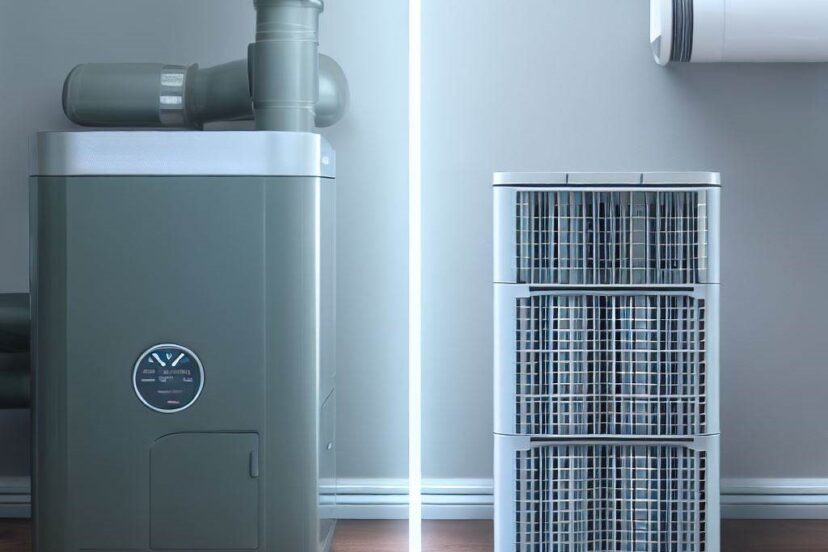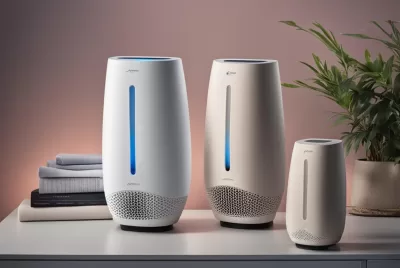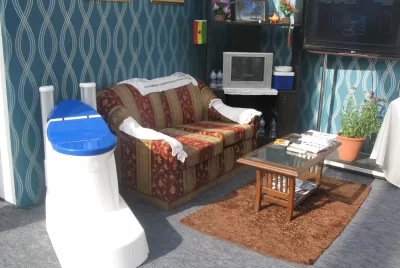Differences Between Air Purifiers and Air Cleaners
"We may earn a commission for purchases made using our links. Please see our disclosure to learn more."
Decoding the Differences: Air Purifiers and Air Cleaners Explained
Air purifiers and air cleaners – these aren’t just the buzzwords of the health-conscious or those fancying the latest gadgets. They have become essential tools in our fight against increasingly polluted indoor air.
The devices have one goal: to help us breathe easier and live healthier. But, despite their shared objective, air purifiers and air cleaners are not the same thing, and understanding their differences is crucial to optimizing our indoor air quality.
That’s right, folks. The world of indoor air technology is more than just a couple of cool gizmos that promise you a breath of fresh air. It’s about understanding the distinct mechanisms that air purifiers and air cleaners utilize in their quest to eliminate unwelcome particles from your breathing space.
The question is: What sets them apart? And more importantly, which one is right for you?
In this article, we’re going to cut through the smog of uncertainty and shed light on the differences between air purifiers and air cleaners. Our goal? To give you the clear, simple, and straightforward information you need to make the best decision for your home and your health.
So, let’s take a deep breath and dive right into the world of indoor air quality solutions.
Understanding Indoor Air Quality: The Role of Air Cleaners and Air Purifiers
Breathe in, breathe out. Seems simple, right? But, what if the air you’re breathing in isn’t as clean as you thought?
According to the Environmental Protection Agency, indoor air can be two to five times more polluted than outdoor air. And since we spend about 90% of our time indoors, the quality of our indoor air isn’t something to ignore.
Enter air cleaning devices – the superheroes of our living spaces. They swoop in and scrub our air clean, protecting us from dust, pollen, and an alphabet soup of pollutants. But not all heroes wear the same cape. In the world of indoor air cleaning, two devices often get mistaken for one another – air cleaners and air purifiers.
They might sound like they’re cut from the same cloth, but each serves a unique purpose in the realm of air quality.
So, let’s demystify the first one on our list:
I. What is an Air Cleaner?
An air cleaner – it sounds pretty straightforward, right? It’s in the name: a device that cleans your air. But there’s more to it than that.
A. Definition and Basic Functionality of Air Cleaners
In the simplest terms, an air cleaner is a device that removes contaminants from the air. However, the way it achieves this can vary, depending on the type of air cleaner. Some air cleaners use filters to physically trap pollutants, while others use methods like ionization to attract and neutralize airborne particles.
Air cleaners play a crucial role in maintaining indoor air quality, especially in environments where allergens, dust, or smoke are prevalent. They tirelessly work to filter out the nasties, letting you breathe a sigh of relief – literally.
B. Types of Air Cleaners
Air cleaners come in various shapes and sizes, each uniquely equipped to wage war against airborne nasties. They are broadly categorized into the following types:
- Mechanical Filters: These are the traditional air cleaners that use physical filters, like high-efficiency particulate air (HEPA) filters, to trap pollutants. Think of them as the bouncers of the air cleaning world – they catch unwanted particles and show them the door.
- Electronic Air Cleaners: These high-tech cleaners use electrostatic attraction to trap charged particles. Ionizers and electrostatic precipitators fall into this category. They’re like the magnet of the air cleaning world, pulling in and neutralizing the airborne invaders.
- Ultraviolet Germicidal Irradiation (UVGI) Cleaners: These cleaners use UV lamps to kill bacteria, viruses, and other pathogens. They are the sanitizers of the air cleaning world, zapping harmful organisms with UV light.
- Gas Phase Air Filters: These target gaseous pollutants that aren’t caught by other types of filters. They are the detectives of the air cleaning world, removing elusive gaseous culprits that others can’t.
II. What is an Air Purifier?
Next on our list is the air purifier. Though often used interchangeably with air cleaner, an air purifier has its own set of rules.
A. Definition and Basic Functionality of Air Purifiers
An air purifier is a device designed to cleanse the air of harmful particles and pollutants.
However, unlike air cleaners, air purifiers typically utilize specific methods such as HEPA filters, activated carbon, or UV light to not only capture but also neutralize harmful particles, thus purifying the air you breathe.
Air purifiers come in handy in homes where residents have allergies, asthma, or other respiratory conditions. They go beyond simply filtering the air, often designed to eliminate smaller, microparticles that can cause or exacerbate health issues.
B. Types of Air Purifiers
Just like air cleaners, air purifiers also come in different forms, each equipped with a unique method of purifying your air:
HEPA Air Purifiers: These devices utilize HEPA filters to trap at least 99.97% of tiny particles as small as 0.3 microns in size. They’re the overachievers of the air purifying world.
- Activated Carbon Air Purifiers: These purifiers use activated carbon to absorb gases, odors, and chemicals that other purifiers may miss. They’re the all-rounders of the air purifying world, ensuring no unwanted element goes unnoticed.
- UV Air Purifiers: Using UV light, these air purifiers are capable of eliminating bacteria, viruses, and other microorganisms, providing an additional layer of protection.
- Ionic Air Purifiers: These devices release charged ions into the air that attach to airborne particles, making them easier to filter out. They’re the innovators of the air purifying world.
III. Air Purifier vs. Air Cleaner: The Key Differences
Now that we’ve introduced our two contenders, it’s time to see how they fare in a head-to-head comparison.
The differences between air cleaners and air purifiers lie primarily in their mechanisms and effectiveness against various airborne particles.
A. Comparison of Mechanisms
Let’s break down how these devices work:
- Air Purifiers: These devices take it a step further. They not only filter the air but also neutralize harmful particles. This neutralization process, whether through HEPA filtration, activated carbon, or UV light, allows air purifiers to tackle smaller, microparticles that can slip through other types of filters.
- Air Cleaners: Generally speaking, air cleaners work like a sieve. They use filters or ionization to capture and remove particles from the air. Some, like UVGI cleaners, can even neutralize harmful microorganisms. But, remember, their methods and effectiveness can vary based on the type of air cleaner.
B. Effectiveness Against Various Airborne Particles
When it comes to tackling airborne particles, both air cleaners and purifiers bring their A-game, but their effectiveness can vary:
- Air Purifiers: Armed with HEPA filters, activated carbon, or UV light, air purifiers can target smaller, harmful particles that air cleaners might miss. They’re especially effective against bacteria, viruses, and gaseous pollutants.
- Air Cleaners: These devices excel at removing larger particles like dust, pollen, and smoke. They can significantly improve air quality in environments where these pollutants are prevalent. However, they might struggle against smaller particles and certain types of gases.
Remember, the right device for you depends on the specific needs of your indoor environment. Consider what pollutants you need to combat before making a choice.
In the next section, we’ll delve deeper into when and where you should consider using an air cleaner or an air purifier. So stay tuned!
IV. Choosing the Right Device for Your Needs
By now, you should have a better grasp of the differences between air cleaners and air purifiers.
But the million-dollar question is: Which one is right for you?
The answer depends on your specific needs and the air quality challenges you face.
A. When to Use an Air Cleaner
Air cleaners are the heavy lifters of the air quality world. They are best suited for environments that face challenges with larger pollutants like dust, pollen, and smoke. Here are a few scenarios where an air cleaner could be your best ally:
- You live in a high-pollen area: If you’re constantly battling sneezes and sniffles during allergy season, an air cleaner with a HEPA filter can help reduce the amount of pollen in your indoor air.
- Your home gets dusty quickly: Homes near busy roads or construction sites can benefit from an air cleaner’s ability to remove dust particles.
- There are smokers in your household: Smoke is a tricky pollutant. An air cleaner, especially one with activated carbon filters, can help reduce smoke particles and associated odors.
B. When to Use an Air Purifier
Air purifiers are the thoroughbreds of the air quality world, designed to tackle smaller, more harmful particles.
They’re the right choice if:
- You or a family member has severe allergies or asthma: Air purifiers can reduce allergens in the air, including tiny particles that can trigger asthma attacks or severe allergic reactions.
- You’re concerned about bacteria and viruses: Air purifiers with UV light can neutralize many microorganisms, reducing the risk of airborne transmission of illnesses.
- You need to tackle odors or gases: If you’re dealing with persistent odors or are sensitive to certain gases, an air purifier with activated carbon can absorb these, leaving your air smelling fresher.
Conclusion
Our journey through the realm of air cleaners and air purifiers has been enlightening, to say the least.
We’ve unmasked the differences, explored their unique functionalities, and understood their effectiveness against various airborne particles.
So, whether you’re looking for a device to filter out larger pollutants or one to tackle tiny, harmful microparticles, the choice between air purifiers and air cleaners is now crystal clear.
Choose the one that best suits your needs and enjoy the breath of fresh air it brings to your home.
Remember, good air quality isn’t a luxury – it’s a necessity.
Make your choice count!




